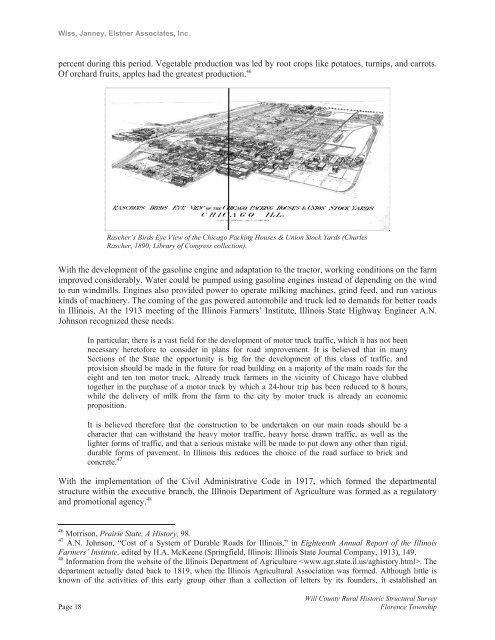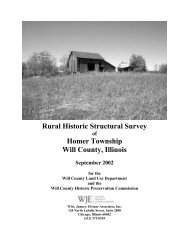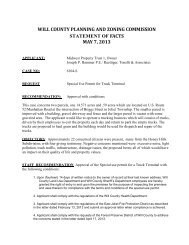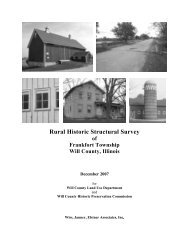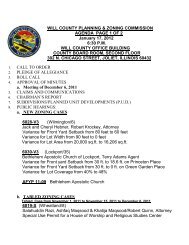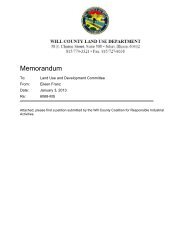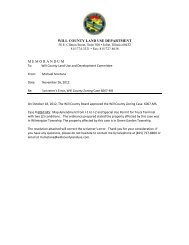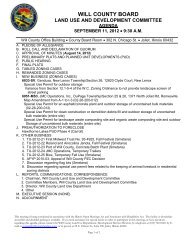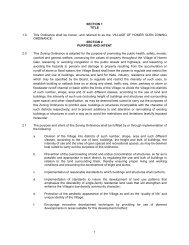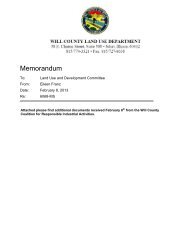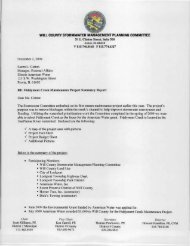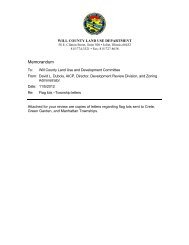Rural H Historic c Struct tural S Survey - Will County Land Use
Rural H Historic c Struct tural S Survey - Will County Land Use
Rural H Historic c Struct tural S Survey - Will County Land Use
You also want an ePaper? Increase the reach of your titles
YUMPU automatically turns print PDFs into web optimized ePapers that Google loves.
Wiss, Janney, Elstner Associates, Inc.<br />
percent during this period. Vegetable production was led by root crops like potatoes, turnips, and carrots.<br />
Of orchard fruits, apples had the greatest production. 46<br />
Rascher’s Birds Eye View of the Chicago Packing Houses & Union Stock Yards (Charles<br />
Rascher, 1890; Library of Congress collection).<br />
With the development of the gasoline engine and adaptation to the tractor, working conditions on the farm<br />
improved considerably. Water could be pumped using gasoline engines instead of depending on the wind<br />
to run windmills. Engines also provided power to operate milking machines, grind feed, and run various<br />
kinds of machinery. The coming of the gas powered automobile and truck led to demands for better roads<br />
in Illinois. At the 1913 meeting of the Illinois Farmers’ Institute, Illinois State Highway Engineer A.N.<br />
Johnson recognized these needs:<br />
In particular, there is a vast field for the development of motor truck traffic, which it has not been<br />
necessary heretofore to consider in plans for road improvement. It is believed that in many<br />
Sections of the State the opportunity is big for the development of this class of traffic, and<br />
provision should be made in the future for road building on a majority of the main roads for the<br />
eight and ten ton motor truck. Already truck farmers in the vicinity of Chicago have clubbed<br />
together in the purchase of a motor truck by which a 24-hour trip has been reduced to 8 hours,<br />
while the delivery of milk from the farm to the city by motor truck is already an economic<br />
proposition.<br />
It is believed therefore that the construction to be undertaken on our main roads should be a<br />
character that can withstand the heavy motor traffic, heavy horse drawn traffic, as well as the<br />
lighter forms of traffic, and that a serious mistake will be made to put down any other than rigid,<br />
durable forms of pavement. In Illinois this reduces the choice of the road surface to brick and<br />
concrete. 47<br />
With the implementation of the Civil Administrative Code in 1917, which formed the departmental<br />
structure within the executive branch, the Illinois Department of Agriculture was formed as a regulatory<br />
and promotional agency. 48<br />
46 Morrison, Prairie State, A History, 98.<br />
47 A.N. Johnson, “Cost of a System of Durable Roads for Illinois,” in Eighteenth Annual Report of the Illinois<br />
Farmers’ Institute, edited by H.A. McKeene (Springfield, Illinois: Illinois State Journal Company, 1913), 149.<br />
48 Information from the website of the Illinois Department of Agriculture . The<br />
department actually dated back to 1819, when the Illinois Agricul<strong>tural</strong> Association was formed. Although little is<br />
known of the activities of this early group other than a collection of letters by its founders, it established an<br />
<strong>Will</strong> <strong>County</strong> <strong>Rural</strong> <strong>Historic</strong> <strong>Struct</strong>ural <strong>Survey</strong><br />
Page 18 Florence Township


